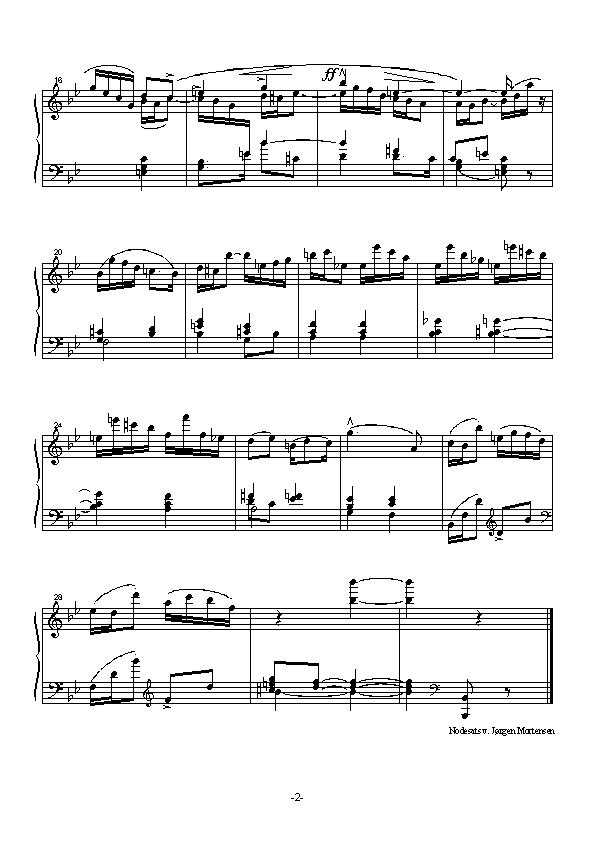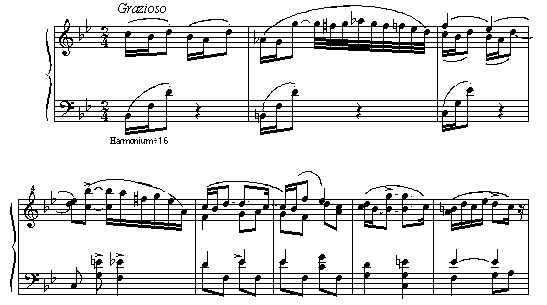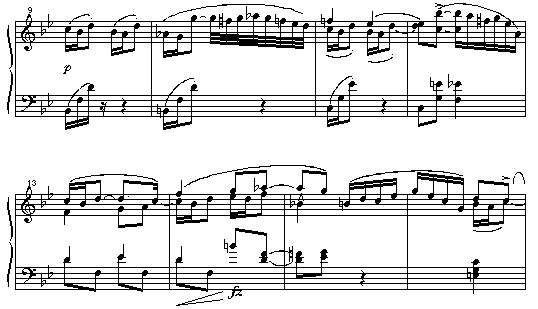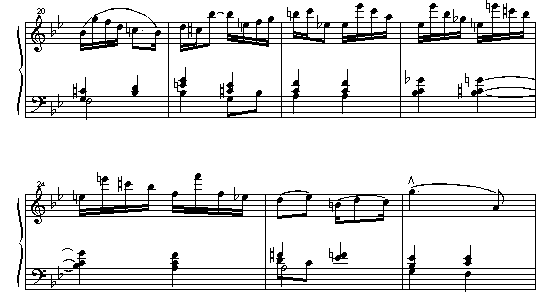Selected works
The Ordrup Movement
By Jørgen Mortensen
A dream
In the night between the 23rd and 24th January 1997 I had the folowing dream:
I am in Ribe, there is to be a meeting with Rued Langgaard. There is a gathering of 20-30 people who are interested in his music. Ribe is much changed in comparison with the physical town; there are buildings of many storeys with walkways between them at several levels.
The meeting is to take place in a large room at ground level. I think that Tage Nielsen and Tove Bjerg Nielsen were among those present. On the floor there was a large sheet of paper, about two by six metres. Rued Langgaard came in, he was a very big man with the strangest of faces. His likeness in the dream was perhaps close to the reality, but in addition he had two unnaturally large upper front teeth, about twice as large as usual, creating an extremely overshot jaw.
Rued Langgaard was clearly extremely pleased to be asked to explain his music, and used the large sheet of paper on the floor to present them to us. We saw drawings illustrating several different compositions, and it became completely clear what was the hidden logic behind all the "strangeness" of these works. This was true both of the strangeness of his style, which was so different, and of the strange aspects of the individual works. For example, it became completely clear for me with what logic and rationality "Le Béguinage" was built up, with all those glimpses of various styles!
Langgaard's presence commanded great respect - we were overwhelmed by the range and quality of his musical genius. He knew all of his compositions by heart, and was able to explain the intentions behind them very clearly. We were bowled over.
At the interval I went up to talk to him. I explained to him that we were working on a major presentation of his music on the Internet. He seemed to be interested, though he obviously did not quite understand ......., possibly apart from the fact that he could see we were friendly and interested.
After the lecture the group wandered out into the weirdly altered town of Ribe, and up the walkways to a pub where we were to have a beer with the composer. I again tried to get in contact with him, as I wanted to tell him how he had given me a deep understanding of his music.
Interpretation of the dream
This dream is still incredibly clear in my mind. There was such an overwhelming force of energy around Langgaard. Why
did I dream a dream like this?
The "residual elements" in the dream - things I had experienced immediately preceeding it - were the fact that I was in fact speculating about the strange and unusual aspects of Langgaard's music, such as the dream innumerated them. A further element, more removed, was a reference by Tage Nielsen to Langgaard's greatness.
These things were of course present to my mind because my view of Langgaard was undergoing a change. Before the publication of Bendt Viinholt Nielsen's Biography in 1993, my general opinion was that Langgaard and his music were simply too odd. This view was radically altered by reading the Biography, and I came to see Langgaard as a deeply fascinating human figure, though I still regarded his music for the most part as odd.
Gradually, as work on this present project developed, though I was still puzzled about this strangeness, I began to be fascinated by many details - for example, the brilliantly wonderful opening of the 1st Symphony. Other insights have come to me like bolts of lightning.
The greatest of these came when we were recording the the little piano movement, "Ordrup", from Chiesa Madre. Ulrich Stærk was going to play it, and I was responsible for the technical arrangements. Neither Ulrich nor I had seen the score before - it was a photocopy of the original, very difficult to decipher. When we had finally managed to read the score, Ulrich played it through as a sort of dress rehearsal.
We were both totally surprised. It was an incredibly good recording, and the music was poetic, beautiful and touching. We decided to let the recording stand, and it is available here in the section containing samples of music - the first ever recording of this movement.
This experience radically changed my attitude to Langgaard, I was simply knocked over by the direct beauty of the music. It was like a rediscovery of Schumann.
But it is not; the music was written in 1949, and this is the riddle: are we looking at a naive pastiche, or a conscious, refined play on older styles - a sort of postmodernism. If the latter is the case, then we are looking at the first pre- postmodernist in the history of music!
The mood of my dream provided a very convincing feeling that the music was not at all naive. If this is the case, then an analysis must surely be able to reveal some inner structural connections beneath the charming surface.
Interpretation of the music
The first example of the score is the fair copy of the whole movement. The score can also be downloaded here as a Finale file, or here as a postscript file.
You can also listen to the recording by Ulrich
Stærk.


The work opens with a three-note motif, C, B flat, D, a step down and a larger interval up. The C is an appoggiatura to B flat and non-harmonic in the tonic chord, B flat, arpeggiated in the left hand.
The three-note opening motif is repeated three times, each time descending, but with the third tone hanging on D and then leaping to G - a natural increase in the tension that is released through the notes rapidly descending. Harmonically the second bar brings the Dominant to C minor, and this tension is also released at the third bar.
In the third bar the the three note opening motif is brought in again - and once again from C, but now in the light of C minor. The motif is again sequenced down, but only once. The third appearance is still there - hidden in the added upper voice. We hear F, E flat, B flat (crotchets), so actually this maintains the triple appearance.
The 4th bar is also finished with some rapid notes, and four bars follow, at first a little hesitatingly over a cadencing B-flat chord over F in the bass, but then the decision is made and the cadenza is formed towards the Tonic of the 9th bar. The opening motif is in the upper voice here, going through a transformation: C, B flat, D; C, B flat, F; C, B flat, G, again with clear intensification towards the cadenza. The rythm is altered playfully.

An overview of the first 8 bars ( A) reveals a grouping of 2 + 2 + 4 bars (a, a1, ba), a small barform. The topnotes are G in the second bar, B flat in the fourth and G again in the seventh - a very deliberate curve. The top notes correspond with harmonic tensions: first the applied Dominant to C minor, then to F major twice. The harmony is quite simple, but the many appoggiaturas and passing notes result in a refined sound with an arabesque-like grace, as in the 8th bar. The regular metre would appear to continue in what follows, at all events we have the first 4 bars repeated as bars 9-13 (except for a smaller change in the rapid notes in the 10th bar).

Measure 13 again brings forward the cadenzing B flat major chord on F in the bass, but the melody turns upwards - the opening motif from C, C and E flat - and the harmony runs away towards C minor, elegantly turned towards E flat major. Another 4-bar period would end up in bar 16, but something peculiar happens in bars 15 -16. For the first time we hear only one voice, circling in C minor, up and down.
Looking at the metre, bars 9-16 (A1) would look something like a a1 ba1, with 4 + 4+ 3 ½ bars, but the final phrase actually doesn't belong anywhere - it is like a short parenthesis. This is remarkable, for we are in the absolute middle of the piece (15 + 15 bars).
The next grouping is also 3 ½ bars long, from the middle of bar 16 through bar 19, where the first rest - a semiquaver - is seen. The dynamical culmination comes here with a fortissimo. The melodic curve ends up on B flat. The harmony offers surprising semitone connections. The opening motif is again heard three times, from B flat, D and A.

The next section is 7 bars - so the twice 3½ bars was apparently not by chance! This section reaches its melodic culmination on the high F, elegantly reached through chromatic passing notes (bars 23-24). The opening motif can be seen in bar 21 (D, C sharp, B flat) and inverted in bar 22 ( B, C, E flat). A stepwise descending bass in bars 24-26 helps release the culmination. The final release is on the B flat major chord in bar 27.

The last four bars (27-30) calmly maintain the B flat major chord. The opening motif again appears three times, again transformed, now: C, B flat, octave B flat; E flat, D, octave D; G, F, B flat. The last appearance is augmented, sounding beautifully over a diminished seventh chord that is conducted to B flat major chord via semitones.

The conlusion is a calm rest on the Tonic. The register is again expanding upwards (high B flat in the third octave) and downwards (contra B flat), but the effect is one of calming down, not inciting as before.
In summary:
Regarding the bars from the middle of measure 16 through to the end as one section (3 ½ + 7 + 4 bars), the overall form of
the movement could be described as A A1 Ba (8 + 7 ½ + 14 ½) - a barform - just like A and A1 were smaller barforms.
The movement is therefore ternary in form, but the nice 4-bar symmetry which the work begins with is somehow
destroyed in the middle - as if this is to be marked in some special way.
In the beginning, the build-up of musical tension is almost idyllic - the Tonic of bar 1 being restated in bar 9. But from then on the tension becomes unexpectedly high; the release does not come until bar 27. In all you will find only 3 (!) Tonic chords in the root position, bars 1, 9 and 27-30. Especially the section from 9-27 is experienced as a relentless search. How calming and idyllic it would have been with regular periods and lots of Tonic chords.
The opening motif plays a great role. It is constantly reshaped and expanded. The three notes return thrice three times in section A, thrice three times in section A1, three times in the section 16-19, only twice (once inverted) in the section towards the culmination, and finally three times in the conclusion, 27-30.
At first glance, then, the movement is graceful and beautiful, perhaps even naïve, but the intense transformation of the motif, the disciplined tonal plan and the rigid maintenance of top notes hold us in an iron grip, in a state of tension far away from the idyllic.
I can only guess about a "hidden" message in the movement, but the symbolism of the number 3 is obvious, the three-note motif so often brought forward three times, the total of 30 measures, and the tonal release in measure 27 (3 x 3 x 3). The fact that 2 periods of 7 bars can also be found seems almost too rare to be mere chance.
The Ordrup Movement is so named because it is associated with the Catholic church in Ordrup and the mood associated with it. According to Bendt Viinholt Nielsen, the whole of Chiesa Madre, which consists of four movements, expresses a religious attitude towards Catholicism. I would presume that the details referred to above are symbolically related to this.
This arabesque quality, the gracefulness, and even the practice of inserting hidden messages into the music inevitably turn one's thoughts in the direction of Schumann.
Even so, Schumann is only used as a stilistic mask, since the movement diverges from Schumann's work on several important points: the insistent, disciplined development of the work, the use of the little three-tone motif, and the almost savage severity in the building up of tension towards the culmination in bar 24.
It could perhaps be said that we are looking at one of the first pre-postmodernists in the history of music!
Jørgen Mortensen, 1997
![]()
![]()